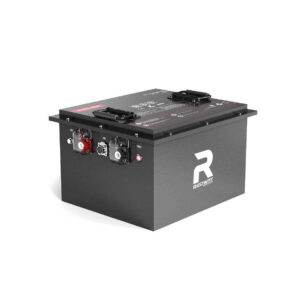Which RV Battery Types Offer the Best ROI for Long-Term Owners?
What Are the Key Factors to Consider When Choosing an RV Battery?
Selecting the best RV battery involves evaluating capacity (Ah), cycle life, weight, maintenance needs, and upfront vs. long-term costs. Lithium-ion batteries, for example, offer higher cycle life and energy density than lead-acid alternatives, reducing replacement frequency and improving ROI over time. Compatibility with solar systems and temperature resilience are also critical for long-term reliability.
How Do Lithium-Ion Batteries Compare to Lead-Acid for RV Use?
Lithium-ion batteries outperform lead-acid in energy efficiency (95% vs. 80%), lifespan (3,000–5,000 cycles vs. 500–1,000), and weight (50% lighter). Though initially 2–3x more expensive, their long-term ROI is superior due to reduced replacements, faster charging, and deeper discharge capabilities. They also require zero maintenance, unlike flooded lead-acid batteries.

For RV owners who frequently boondock or travel in extreme temperatures, lithium’s wider operating range (-4°F to 140°F) ensures reliable performance. Lead-acid batteries suffer capacity loss below freezing and require insulation, adding complexity. While lead-acid remains a budget-friendly option for occasional campers, lithium’s 10-year lifespan makes it ideal for full-time RVers. The table below highlights key differences:
| Feature | Lithium-Ion | Lead-Acid |
|---|---|---|
| Cycle Life | 3,000–5,000 | 500–1,000 |
| Weight (100Ah) | 30 lbs | 60–70 lbs |
| Discharge Depth | 80–100% | 50% |
Can Solar Compatibility Enhance RV Battery ROI?
Yes. Solar-compatible batteries like lithium-ion or advanced AGM optimize energy harvesting, reducing generator reliance and fuel costs. Lithium batteries charge 2x faster from solar panels, maximizing off-grid efficiency. Pairing with an MPPT charge controller further boosts ROI by improving energy conversion rates by up to 30% compared to PWM controllers.
What Maintenance Practices Extend RV Battery Lifespan?
Regular voltage checks, avoiding deep discharges below 50%, and ensuring terminals are clean and corrosion-free extend battery life. For lead-acid, monthly electrolyte top-ups are essential. Lithium batteries require minimal maintenance but benefit from periodic balancing. Storing batteries at 50–80% charge in moderate temperatures (50–77°F) prevents degradation during seasonal RV downtime.
Why Is Temperature Resilience Critical for RV Batteries?
Extreme heat accelerates chemical degradation, while cold reduces capacity by 20–50%. Lithium-ion batteries operate efficiently in -4°F to 140°F, unlike lead-acid, which struggles below 32°F. Built-in battery management systems (BMS) in lithium models prevent overheating and freezing damage, ensuring consistent performance in diverse climates and safeguarding long-term ROI.
Temperature fluctuations cause lead-acid batteries to lose electrolyte fluid through evaporation, necessitating frequent refills. In contrast, lithium batteries use sealed cells and thermal management to maintain stable internal conditions. For winter RVing, lithium’s cold-weather performance eliminates the need for external heating pads, reducing energy drain. The table below compares temperature impacts:
| Condition | Lithium-Ion | AGM |
|---|---|---|
| Capacity at 14°F | 85% | 45% |
| Cycle Life at 95°F | 2,800 cycles | 600 cycles |
How Do Battery Management Systems (BMS) Impact Longevity?
A BMS monitors voltage, temperature, and current, preventing overcharging, deep discharges, and thermal runaway. Lithium batteries with BMS retain 80% capacity after 2,000 cycles, versus unmanaged systems failing at 1,000 cycles. This protection reduces wear, extends lifespan by 2–3x, and minimizes unexpected replacements, directly boosting ROI for long-term RV owners.
Expert Views
“Investing in lithium-ion batteries is a game-changer for RV owners,” says John Merrill, Redway’s energy storage specialist. “Their 10-year lifespan and 95% efficiency mean fewer replacements and lower energy waste. Pair them with solar, and you’re looking at a 40–60% reduction in annual power costs. The upfront cost stings, but the ROI after 3–5 years is undeniable.”
Conclusion
For long-term RV owners, lithium-ion batteries deliver unmatched ROI through superior lifespan, efficiency, and solar compatibility. While AGM or gel batteries suit budget-conscious users, lithium’s maintenance-free design and 3,000+ cycles justify the initial investment. Prioritize BMS-equipped models and pair with solar to maximize savings over a decade of adventures.
FAQ
- Q: How long do lithium RV batteries last?
- A: 10+ years with 3,000–5,000 cycles, outperforming lead-acid’s 3–5-year lifespan.
- Q: Are AGM batteries worth it for RVs?
- A: Yes for moderate budgets—maintenance-free and better cycle life (500–1,000) than flooded lead-acid.
- Q: Do RV batteries work with solar panels?
- A: Yes, especially lithium and AGM. Use an MPPT controller for optimal efficiency.
